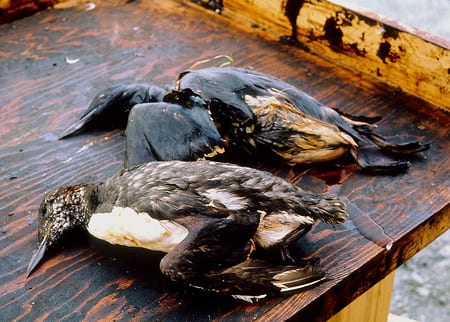Exxon Valdez Oil Spill Facts
 On March 23, 1989, at 9:12 pm the Exxon Valdez oil tanker left the Alyeska Pipeline to cross Prince William Sound carrying approximately 53 million gallons of crude oil. The tanker was headed for Long Beach, California. Three hours later, just after midnight on March 24th, the Exxon Valdez ran into Bligh Reef, spilling 10.8 million gallons of oil into the sound.
On March 23, 1989, at 9:12 pm the Exxon Valdez oil tanker left the Alyeska Pipeline to cross Prince William Sound carrying approximately 53 million gallons of crude oil. The tanker was headed for Long Beach, California. Three hours later, just after midnight on March 24th, the Exxon Valdez ran into Bligh Reef, spilling 10.8 million gallons of oil into the sound.
Here are some of the most startling statistics about the effects of the Exxon Valdez spill on marine wildlife, fisheries and the region’s economy:
- The amount of oil spilled could fill 125 Olympic-sized swimming pools.
- As many as 2,800 sea otters, 300 harbor seals, 900 bald eagles and 250,000 seabirds died in the days following the disaster.
- 1,300 miles of coastline were hit by the oil spill.
- 1,000 harlequin ducks were killed by the oil spill, in addition to many chronic injuries that occurred as a result of the long term effects of the spill.
- The cleanup required about 10,000 workers, 1,000 boats and roughly 100 airplanes and helicopters.
- Four deaths were directly associated with cleanup efforts.
- The spill caused over $300 million of economic harm to more than 32 thousand people whose livelihoods depended on commercial fishing.
- Tourism spending decreased by eight percent in south central Alaska and by 35 percent in southwest Alaska in the year after the spill.
- There was a loss of 9,400 visitors and $5.5 million in state spending.
- Many fish populations were harmed during the spill. For example, sand lance populations went down in 1989 and 1990, herring returns were significantly fewer in 1992 and 1994 and adult fish had high rates of viral infections.
- Pink salmon embryos continued to be harmed and killed by oil that remained on stones and gravel of stream banks through at least 1993. As a result, the southwestern part of Prince William Sound lost 1.9 million or 28 percent of its potential stock of wild pink salmon. By 1992, this part of the sound still had 6 percent less of the wild pink salmon stock than was estimated to have existed if the spill had not occurred.
- Two years following the Exxon Valdez spill, the economic losses to recreational fishing were estimated to be $31 million.
- Twelve years after the spill, oil could still be found on half of the 91 randomly selected beaches surveyed.
- Three species of cormorant, the common loon, the harbor seal, the harlequin duck, the pacific herring and the pigeon guillemot still have not fully recovered.
Help us stop future oil spills and protect wildlife. Donate today!



